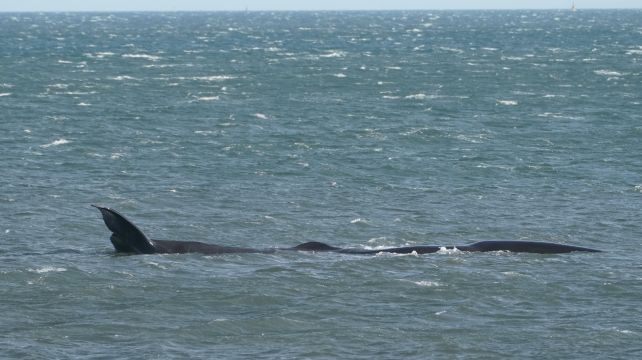New research suggests that in some areas of the Mediterranean the animals are less likely to forage for food at dawn.
The study, led by the University of East Anglia (UEA), has revealed the daily habits of the endangered Mediterranean sperm whale.
Unmanned underwater gliders – robots – equipped with acoustic monitors recorded the sperm whale sounds – or clicks – over several months and thousands of miles of ocean.
Sperm whales produce distinct types of clicks for both echolocation and social interaction purposes.
The study, published in Endangered Species Research, focused on the extremely powerful and highly directional “usual clicks” produced while foraging.
It confirmed the whales’ widespread presence in the north-western Mediterranean Sea and identified a possible hot spot for sperm whale habitat in the Gulf of Lion, along the coast of France and Spain, where a higher rate of clicks was found.
Researchers said this could indicate a higher number of whales, but could also be for behavioural reasons.
Continuous day and night monitoring during winter months suggests different foraging strategies between different areas.
In the Ligurian Sea, between the Italian Riviera and Corsica, mobile and scattered individual whales forage at all times of day, and in the Sea of Sardinia usual clicks were also detected at all times of the day.
But in the Gulf of Lion larger groups target intense oceanographic features in the open ocean with acoustic activity showing a clear 24-hour pattern and decreased foraging effort at dawn.
The clear daily pattern identified in our results appear to suggest that the sperm whales are adapting their foraging strategy to local prey behaviour
Scientists said this could suggest the whales may have modified their usual foraging pattern of eating at any time to adapt to local prey availability.
It provides a clue regarding sperm whale diet in this area and may be what makes it attractive to them.
Lead author Pierre Cauchy, a postgraduate researcher at UEA’s Centre for Ocean and Atmospheric Sciences (Coas) and the Centre for Environment, Fisheries and Aquaculture Science (Cefas), said their findings would help conservation efforts.
He added: “Information on the ecology of the Mediterranean sperm whale subpopulation remains sparse and does not meet the needs of conservation managers and policy-makers.
“Increasing observation efforts, particularly in winter months, will help us better understand habitat use, and identify key seasonal habitats to allow appropriate management of shipping and fishing activities.
“The clear daily pattern identified in our results appear to suggest that the sperm whales are adapting their foraging strategy to local prey behaviour.
“The findings also indicate a geographical pattern to their daily behaviour in the winter season.”
There are fewer than 2,500 mature individual Mediterranean sperm whales and threats to them include being caught as bycatch in fishing nets and, as recently the case off the Italian coast, entanglement in illegal fishing gear.
Other dangers are ship strikes, ingestion of marine debris, and disturbance by human-made noise and whale-watching activities.
Sperm whales spend a substantial amount of their time foraging, and, when in a foraging cycle, they produce usual clicks 60% of the time.
These are therefore a reliable indicator of sperm whale presence and foraging activity, and their specific features allow them to be identified and detected up to a distance of 2.5 miles (4km) to 12.5 miles (20km).
The study analysed sounds recorded by passive acoustic monitoring (Pam) sensors, previously successfully used for weather observation, on gliders deployed by the team to collect oceanographic data during winter 2012-2013 and June 2014, covering 1,988 miles (3,200km).
The study involved researchers from UEA and the Centre for Environment, Fisheries and Aquaculture Science (Cefas), the Scottish Association for Marine Science (Sams), University of Gothenburg and Sorbonne University.







